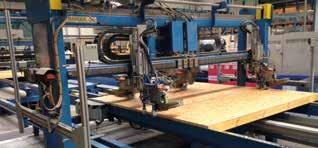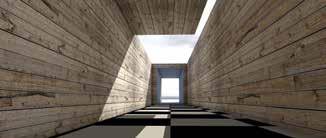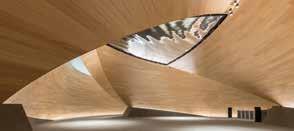
17 minute read
SILVER SERVICE
As we celebrate 25 editions of Structural Timber Magazine, we thought we would take a quick flick through some back issues and pick out some memorable moments from the many industry developments and projects we have featured.
Since its first outing in October 2014, Structural Timber Magazine has seen the timber sector change shape and develop rapidly – especially with the boost in understanding of offsite manufacture and factory-based methods. However, the success of timber has always rested on its merits as the most sustainable of all mainstream construction materials. But with the growing climate emergency, needs of the circular economy and healthier buildings more vital than ever, timber delivers many benefits as only such a renewable, natural material can bring.
Of course the huge growth in the use of engineered timber over the last decade in particular – especially cross laminated timber (CLT) and glulam – has seen architects and structural engineers take timber to exceptional new heights. Sometimes literally – which in itself has become a bone of contention in the wake of the Grenfell tragedy with arguments still unresolved over the 18m mark. So the construction industry is full of vagaries that are often very hard to predict. A perfect example over the publication timeline of the magazine, was the promotion of the 2016 zero carbon homes targets – then unceremoniously scrapped alongside the respected Zero Carbon Hub by the David Cameron Government – to the present refocusing of those same requirements to achieve net zero emissions targets by 2050.
The debate surrounding the dearth of housing provision across the UK has also underpinned much of the talk of more sustainable housing and communities All those 300,000 homes we are told are needed per annum, aren’t going to be delivered via the usual building routes and traditional construction methods. But its more about the increasing requirements of reliability, quality and better industry productivity and performance across the board – using ‘fabric first’ principles to deliver better buildings. There has also been an admission, or at least an acceptance, at government level that offsite construction is a serious proposition and timber can benefit hugely from this. Mark Farmer’s ‘Modernise or Die’ report was commissioned and published at just the right moment in 2016 and focused minds across all levels of the built environment.
It is sometimes the Editor’s burden to decide what to include and what to leave out. Over 25 magazines we have attempted to provide a solid overview of the structural timber world in all its many systems and industry developments, with a range of opinions from across the timber supply chain. Outside of the timber bubble you can be easily forgiven for not quite understanding what makes the sector tick, so I hope over 25 issues that we have succeeded in bringing some of that into focus.
Over the next few pages we have picked out some key features. This is not an exhaustive round-up of the huge amount of material the magazine has covered over the last six years! Certainly there have been so many stunning projects using timber that have been championed at the Structural Timber Awards – literally hundreds and hundreds of outstanding buildings – that we could write a book.
If you’d like to contribute to the magazine in any way in 2021 – an opinion column, industry feature, technical information, a great project or just a news story – please get in touch through the usual channels. Email: info@structuraltimbermagazine.co.uk
www.ghanatimber.org
ISSUE 1 A New Beginning
The then Chairman of the STA, Lawrence Young, reflected on a year of progress for the STA since its rebranding. After changing focus from the UK Timber Frame Association (UKTFA) to the Structural Timber Association (STA) it was the biggest rebrand in the Association’s history, gaining a host of new members and witnessing a significant upturn in the industry. The rebrand from the UKTFA at Timber Expo, September 2013 was carried out with the intention of creating a stronger voice for the timber frame and structural timber industry within the UK and recognised the fact that many members were working with and producing hybrid structural timber solutions, including glulam, cross laminated timber and structural insulated panels alongside timber frame. Much talk in our launch issue surrounded the shortage of housing stock across the UK and how to solve it. Some things have not changed.
ISSUE 3 NW Bicester: taking shape in 2015

As the UK’s first eco-town, many were watching the continued development of the vibrant community of North West Bicester and its sustainable and greener lifestyle journey. Timber played a major role in the housing scheme with Stewart Milne Timber Systems a key provider. It would seem that Garden Cities were well and truly back on the UK’s cultural agenda – originally designed to alleviate crowded city living in the 19th century, the current housing shortage has seen us go back to the future for inspiration. With work taking place between 2010-2017, the One Planet Community is now a 6,000-home extension to the market town of Bicester, with highly sustainable, true zerocarbon homes plus workplaces, schools, community facilities and many green space. The concept of 2016 zero carbon homes targets were still valid although were soon to be shelved before eventually being reanimated in a 2019 as net zero commitments.
ISSUE 2 Growing our Low Carbon Economy
We featured a new report backed by the Timber Accord – the short-lived alliance of the UK’s timber trade associations. ‘Growing Our Low Carbon Economy’ was sent to policy makers at both national and local level to emphasise the critical role timber plays, suggesting 12 policy areas where the UK Government should focus their attention. David Hopkins, (then Executive Director of Wood for Good) explained: “Our aim with this report is to give policy makers a clear understanding of the benefits the timber supply chain brings to the environment, economy and society as a whole. It details key areas where timber can help the UK Government meet its own objectives in reducing carbon emissions, provide a source of sustainable jobs and economic growth, play a vital role in delivering tomorrow’s housing stock and sit at the centre of future health and well-being agendas.”
ISSUE 4 The Death-Star Capsule
Unit3Sixty was believed to be the first near complete offsite modular timber skatepark in the world, featuring Europe’s biggest indoor wooden bowl – David & Goliath – including the world’s first rideable free-standing timber hemisphere – The Death-Star Capsule. A second room included more street inspired shapes and a jump training area to complete the park. The creative design not only provided an incredible user experience but stands as a demonstration of what is possible using offsite engineered timber shapes in general. We also reported on the launch of the ‘new and inclusive’ Confederation of Timber Industries (CTI). The CTI vision – still current – is about: “Growing the supply chain and the market, nurturing the skills in education and the sustainability agenda. Wood needs to become the product of first choice. We can achieve this target together.” The CTI has worked hard at lobbying government especially through its Save Safe Structural Timber campaign.

Construction with a conscience

Kronobuild® Eco friendly T&G boards
Help reduce environmental impact with the Kronobuild range of structural T&G boards, manufactured in the UK from recycled and sustainably managed timber. Fast Protect and Fast Clean have peel-off layers that protect against the weather and spillages for 60 days, they are 100% recyclable and available for fast nationwide delivery. Advanced manufacturing technology provides uniform quality and structural integrity, with diamond tooled precision joints and a readily machinable composition. For more information or to order samples visit www.uk.kronospan-express.com/en Engineered to perform
Kronobuild® Fast Protect

Kronobuild® Fast Clean Kronobuild® P5
ISSUE 5 National Structural Timber Specification
The long-awaited new National Structural Timber Specification (NSTS) document was published. The NSTS marked a significant step forward for the timber industry in levelling the playing field against competing materials such as steel and concrete. Both the steel and concrete industries already have National Specification publications – in fact steel’s ‘black book’ is already into its fifth edition – but the timber industry has been slower in this area. The brainchild of TRADA: “The publication of the NSTS is not a small step forward but rather a giant leap.” We also reported on the Government’s axing of the long-established 2016 zero carbon homes policy. Julie Hirigoyen, Chief Executive of the UKGBC echoed many saying: “The speed and the stealth with which this administration has destroyed some of the long-term policies supporting the renewable and low carbon industries has been breath-taking.”
ISSUE 10 New Dimensions in Timber
Winner of the Pioneer Award at the Structural Timber Awards 2016, Arup has an enviable track record in timber. We heard from Andrew Lawrence, Associate Director and one of Arup’s timber specialists, who discussed why they are so committed to timber and his vision for the future of the industry. “Everyone talks about sustainability, but the fact is that very few clients will pay more for it, so we need to develop competitive timber solutions,” said Andrew. “The way to do that is to understand the economic drivers of the material and to design the project around timber from the start.” We also showed how the 104-home Cobalt Place – the world’s largest cross laminated timber (CLT) residential development – showcased exposed CLT walls and ceilings and was designed to create a blueprint for developing successful sustainable homes at scale.

ISSUE 8 SMTS Witney

The UK’s leading timber homebuilder and systems provider needs little introduction. We took a tour of Stewart Milne Timber Systems (SMTS) Witney facility, just outside Oxford. As part of the Structural Timber Association’s event programme, visitors saw and heard more about their products and practices. At the heart of SMTS success has been its SIGMA system and in particular the SIGMA II closed timber panel. We saw how the twin concepts of a fabric first approach combined with offsite manufacture is proving an effective way in maximising energy efficiency and controlling build costs. The £10million Witney facility is one of the largest and most advanced timber frame operations in Europe and since its opening in 2003, the purpose-built manufacturing facility is producing approx. 225 housing kits per week or one house every 20-30 minutes.
ISSUE 11 EGGER ‘s New T&G Line

EGGER opened up the doors of its Hexham plant to unveil the latest developments in its building products division and the multi-million investment in its new tongue and groove (T&G) panel processing line – one that produces over 6.5 million EGGER Advanced Structural Flooring panels every year. The new T&G panel processing and packaging line also included further processing facilities with a lamination line and the development of an onsite demonstration rig and testing area for its structural flooring products. “With technological advances in clean or renewable energy, construction materials and offsite building methodologies, the net zero benchmark for energy performance in buildings has become achievable.” We also heard from Neil Smith, CEO of Net Zero Buildings who outlined its Schoolhaus design – one of the UK’s most energy efficient school buildings using SIP technology – and run at a fraction of the cost of alternative materials.





















ISSUE 14 Saving Energy Saving Money
Fabric First has long been the heartbeat of the timber sector. A Roundtable Event hosted by DuPont tackled what the timber sector can do better for the environment and building owners and occupiers. “Fabric First is what we talk about,” said DuPont’s Bradley Cameron. “What we often see is ‘Fabric Last’. Developers have built something then have to ‘wrap it up’ which causes problems and is an expensive thing to do, rather than getting it right in the first place. If you don’t get that right, then the amount of insulation you end up using doesn’t work like it should.” The potential of virtual reality and an augmented future in the construction industry could be endless. We spoke to one of the leading facilities in the UK helping manufacturers to become more competitive and attuned to advanced technologies and processes – the University of Sheffield’s Advanced Manufacturing Research Centre (AMRC).

ISSUE 16 Exploring Offsite Opportunities

When Chris Thompson, Managing Director of sustainable urban developers, Citu, realised that outdated construction methods would hold back his ambition to accelerate the transition to low carbon cities, he set out to revolutionise the way in which homes are designed and built in the UK. He spoke to us about the construction of the first Citu low carbon homes at the Climate Innovation District in Leeds’s South Bank. This marked a major milestone as the scheme was the largest ecologically pioneering district of this scale in the UK – providing healthier, smarter and better-connected cities. We also heard from Dominic Raab (then Minister for Housing) about the role that offsite manufacture can play in solving many of the UK’s housing problems. “For too long, productivity and innovation in construction have lagged behind other industries. Modern methods of construction (MMC) are a chance to change that.”
ISSUE 15 Warmth, Wellbeing & Wow Factor
With a 98.5% BREEAM score – the highest design-stage score ever achieved by any major office development – the London HQ for US media giant Bloomberg contained much timber in its design and was hailed as the world’s most sustainable office building. Located in the heart of the City of London and designed by Foster + Partners, it was the first wholly-owned and designed Bloomberg building in the world, bringing Bloomberg’s 4,000 London-based employees under one roof for the first time. We also took a look inside The Oculus. The University of Warwick’s flagship building – the first on the campus to be dedicated purely to teaching and learning – reflected its green surroundings through the use of terracotta, sandstone and spectacular timber technology including glulam beams. The building was also the venue for one of the highly successful Solid Wood Solutions conferences and exhibitions.

ISSUE 17 Healthy Living in Shropshire
An innovative £2million timber frame Passivhaus social housing development, completed and delivered a super low-carbon scheme to residents and South Shropshire Housing Association. This mix of one, two and threebedroom homes was handed over at the landmark Callaughtons Ash, in Much Wenlock. The project comprised of two shared ownership and 10 homes for social rental. This highly sustainable development has been seen as an exemplar model for unlocking small green sites and improving the quality of family living in rural areas. With excess moisture within any building causing a variety of problems, Niall Crosson, Group Technical Manager at Ecological Building Systems and Michael Foerster, Engineer Head of Applications Technology at pro clima, discussed the ways to ensure that unforeseen moisture trapped during the construction phase can be released from the building envelope and avoid damage to timber over time.

ISSUE 18 The Future is Made of Trees

The magazine took a trip to Sweden. With over 51,000 members, Södra is Sweden’s largest forest-owner association with a business built on ‘value-generating’ relationships. A full tour of the timber supply chain from nursery and forest, to the loading of timber at the Port of Varo, revealed the many ways that the timber sector across Europe is thriving but also (as Brexit talks ground on…) totally interconnected. Announcements on legislation regarding banning the use of combustible materials in the external walls of high-rise residential buildings grabbed the building headlines. Anthony Thistleton, co-founder of leading architects Waugh Thistleton, told us that: “This should not impede the success of structural timber including cross laminated timber (CLT)… and a quiet revolution has been going on in building in the UK over the last few years that has the capacity to transform the delivery of new housing.” That revolution is inextricably tied up with the increased use of CLT.
ISSUE 20 Delivering Tomorrow’s Quality Today
David Russell, Director at Carbon Futures, told us how offsite and timber construction can deliver far-reaching thermal improvements for new UK housing as the Committee on Climate Change asked if the UK’s housing was “fit for the future”. The report listed five key priorities for government action: performance and compliance, the skills gap, retrofitting existing homes, building new homes and financing and funding. All of which can be improved through the use of more wood. We also reported on the huge Ministry of Defence housing development taking place on Salisbury Plain using timber frame to house military personnel and their families returning from Germany. As the final phase neared completion, three new housing and community schemes – Bulford, Ludgershall and Larkhill – were being built and successfully using timber frame systems from Stewart Milne Timber System (SMTS) and Taylor Lane.

ISSUE 19 Transformational Timber
For over 30 years, Professor Alex de Rijke, Founding Director at dRMM Architects and one of the UK’s leading architectural practices, has been an outspoken advocate of engineered timber and outlined why it is so essential to contemporary building design, championing its: “Outstanding versatility, weight-tostrength performance, sustainability, speed and limitless expression. I will continue to (promote it…) in the UK and internationally, with the added imperative of the climate change crisis.” We also took a look inside the stunning, awardwinning Cambridge Mosque. Combining Islamic principles with European sensibilities, the mosque’s main features are its goldclad dome and the vast timber structure, which was designed and manufactured by Blumer-Lehmann AG in Gossau, Switzerland. This masterpiece of timber construction and engineering also incorporates solar energy generation and rainwater harvesting to create a fantastic overall sustainable and low energy space.
ISSUE 21 Hitting the Timber High Notes
Multi-disciplinary engineering firm, Cundall, discussed the triumph of timber in musical education and how the award-winning King’s College School, Wimbledon’s state-ofthe-art new music school is an: “Achievement of client vision, innovative architecture and structural design.” Key to the project’s success was the integrated approach between the architect, engineers, the school and the wider project team. The Hopkins Architect’sdesigned music school is arranged over three floors and home to 200-seat concert hall. Volumetric modular timber was under the spotlight as Urban Splash announced a deal to bring Japan’s biggest housebuilder – Sekisui House – to the UK, helping the developer create more modular timber homes. As a wake-up call to many, on their arrival in the UK market: “Sekisui House were genuinely surprised that the UK industry was so out-dated and we could have a housing crisis.”



